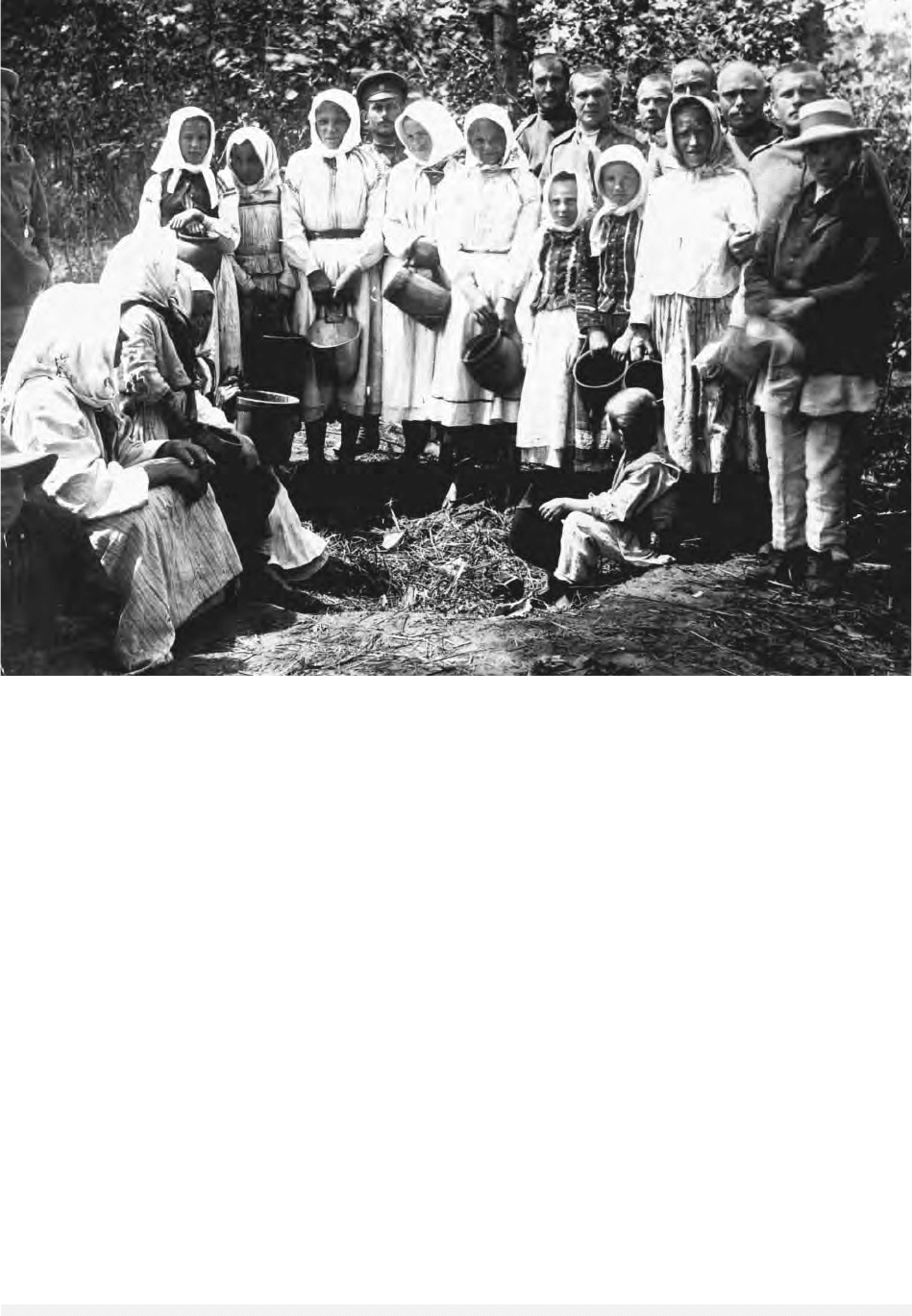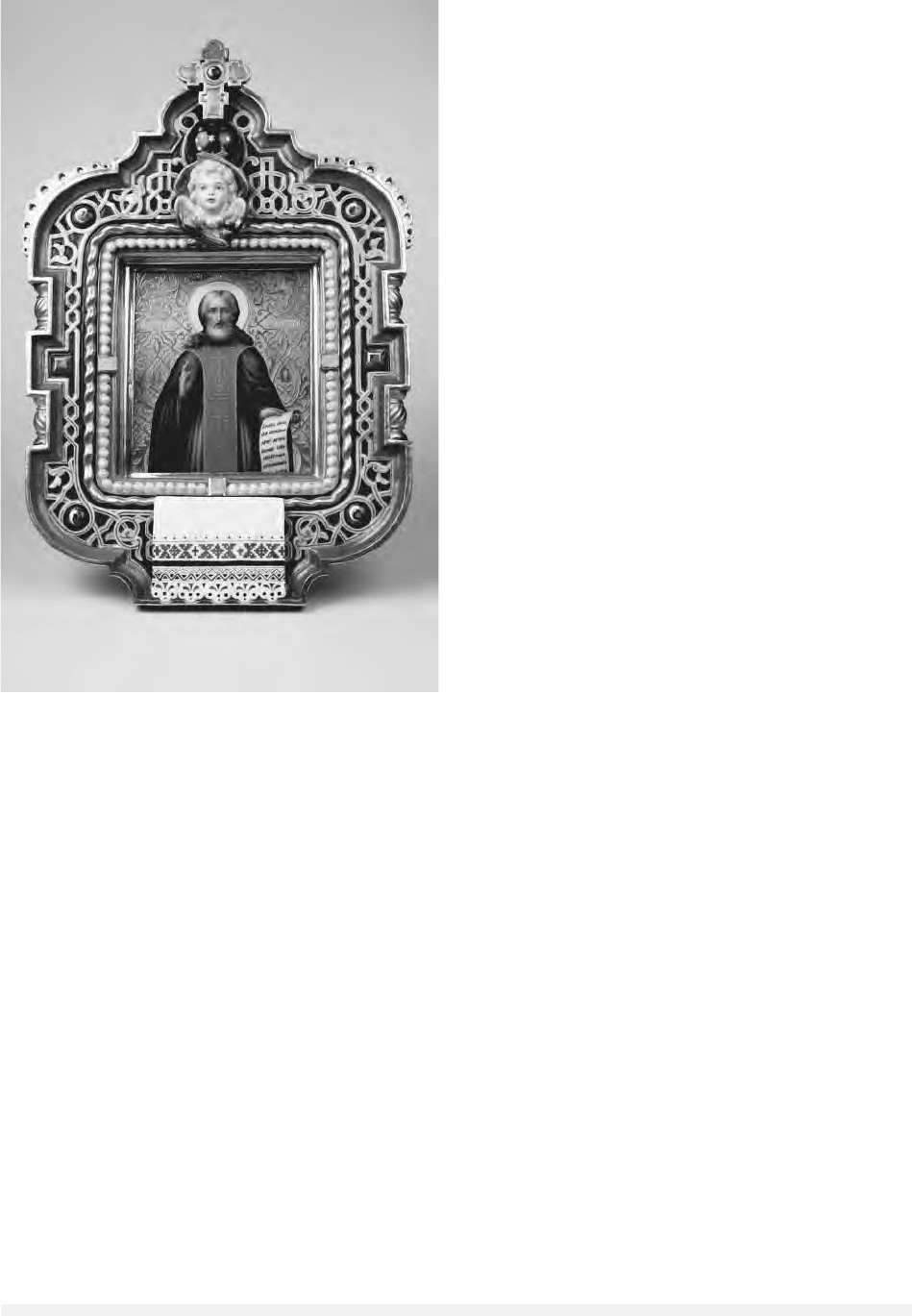Encyclopedia of Russian History
Подождите немного. Документ загружается.


influence on actual decision-making. And far from
being a springboard for ambitious politicians, it
was more a tool for Boris Yeltsin to balance rival
figures.
Skokov was replaced as secretary in June 1993
by a former Soviet general, Yevgeny Shaposhnikov,
and then in October 1993 by a Yeltsin crony, Oleg
Lobov. In June 1996 Alexander Lebed was ap-
pointed secretary, in return for his support of
Yeltsin in the second round of the presidential elec-
tion. Lebed was assigned to end the war in Chech-
nya, and much to everyone’s surprise he succeeded,
signing a peace accord and withdrawing Russian
troops. Concerned about Lebed’s growing popular-
ity, Yeltsin created a separate Defense Council in
July and fired Lebed in October, accusing him of
plotting a military coup. Lebed was replaced by the
anodyne politician Ivan Rybkin, with the contro-
versial oligarch Boris Berezovsky as his deputy, in
charge of reconstructing Chechnya. (Berezovsky
quit in November 1997.)
From March to September 1998, the Security
Council was headed by an academic, Andrei
Kokoshin. He was replaced by a KGB general, Niko-
lai Boryuzha, who in turn was followed in March
1999 by Vladimir Putin, who was simultaneously
head of the Federal Security Service (FSB). In No-
vember 1999 Putin was replaced at the council by
his deputy at the FSB, Sergei Ivanov. In March 2001
Ivanov became defense minister, and the former in-
terior minister, Vladimir Rushailo, became Security
Council secretary.
During Vladimir Putin’s presidency, the Secu-
rity Council became slightly more visible as a fo-
rum through which he tried to press forward with
military reforms obstinately resisted by the gener-
als. The new National Security Concept drawn up
by the council in 2000 stressed internal threats,
such as Chechen terrorism, over traditional secu-
rity concerns, such as nuclear deterrence.
See also: POLITBURO; PRESIDENCY; PRESIDENTIAL COUN-
CIL
BIBLIOGRAPHY
Adams, Jan. S. (1996). “The Russian National Security
Council.” Problems of Post-Communism 43(1):35–42.
Derleth, J. William. (1996). “The Evolution of the Rus-
sian Polity: The Case of the Security Council.” Com-
munist and Post-Communist Studies 29(1):43–58.
P
ETER
R
UTLAND
SERAPION BROTHERS
The Serapion Brothers were a group of poets and
writers who insisted on the political autonomy of
the artist and the affirmation of imagination and
creative art. They argued that in order to remain au-
thentic, the writer’s voice needed freedom from all
social or political constraints. They denounced the
use of literature for utilitarian purposes and never
adopted a specific model of literary production.
The Serapion Brothers began meeting in 1921
at the Petrograd House of Arts at the suggestion of
Viktor Shklovsky. The group, which eventually
included Konstantin Fedin, Ilya Gruzdev, Vsevolod
Ivanov, Veniamin Kaverin, Lev Lunts, Nikolai
Nikitin, Elizaveta Polonskaya, Vladimir Pozner,
Mikhail Slonimsky, Nikolai Tikhonov, and Mikhail
Zoshchenko, adopted its name after a tale by E. T.
A. Hoffmann. Shklovsky occasionally participated,
and Maxim Gorky supported members with ma-
terial assistance and help in publishing their work.
The group met weekly to read and discuss one an-
other’s work, focusing on the refinement of the
craft of writing and leaving each member to de-
velop his or her own message, sometimes engag-
ing in heated debates about the purpose or meaning
of literature.
The closest the Brotherhood came to publish-
ing a manifesto was Lev Lunts’s “Why We are the
Serapion Brothers” (Pochemu my Serapionovy Bratya,
1922), in which he proclaimed that “Art is real, like
life itself. And, like life itself, it is without goal and
without meaning: It exists because it cannot help
but exist.” This statement of the group’s purpose
sparked a sharp debate with Marxist critics who
insisted on the utilitarian use of literature for com-
mon ideological purposes. Lunts, however, stressed
the autonomy of literature from political purposes
or control and, simultaneously, the preservation of
diverse ideological positions within the brother-
hood. The one collective work the group published,
the First Almanac (Serapionovy Brat’ia. Al’mankh
pervy, 1922) demonstrates this wide range of style
and philosophy. Throughout the 1920s they
promoted a nonpolitical approach to literature, tol-
erance, and friendship, and their connections con-
tinued after the group’s dissolution in 1929.
See also: CULTURAL REVOLUTION
BIBLIOGRAPHY
Hickey, Martha Weitzel. (1999). “Recovering the Au-
thor’s Part: The Serapion Brothers in Petrograd.”
Russian Review 58(1):103–123.
SERAPION BROTHERS
1363
ENCYCLOPEDIA OF RUSSIAN HISTORY

Kern, Gary, and Collins, Christopher, eds. (1975). The
Serapion Brothers: A Critical Anthology. Ann Arbor:
Ardis.
E
LIZABETH
J
ONES
H
EMENWAY
SERBIA, RELATIONS WITH
From the first days of the initial Serb uprising in
1804 (against the tyranny of the Janissaries, mil-
itary units that had evolved from being the elite
troops of the Ottoman Empire into semi-indepen-
dent occupiers) until 1878 (when Belgrade obtained
complete independence from the Porte at the Con-
gress of Berlin), relations with Serbia were central
to Russia’s foreign policy. However, as Serbia pur-
sued both independence from Istanbul and expan-
sion of the state to include all Serb lands (Bosnia,
Hercegovina, Kosovo, Montenegro, and Vojvodina),
Russia often found itself drawn into Serbian for-
eign affairs as Belgrade came to depend upon (and
use) Russian support for its own ends. This led to
a relationship that offered Serbia the greatest ad-
vantages as St. Petersburg became captive to two
critical forces: 1) the emergence of Panslavism, a
movement that stressed the solidarity of the Slavic
peoples ostensibly under Russian leadership, and
2) the Eastern Question, the increasing vacuum in
southeastern Europe brought about by the rapid
decay of the once great Ottoman Empire, which
presented an inviting target of opportunity for the
great powers.
The romantic image of Orthodox Christians
fighting the Muslim Turks for freedom continu-
ously vexed St. Petersburg. On the one hand, ad-
visers generally supported a policy of moderation
in the region and a concentration on domestic
needs. However, Panslavists, who had a powerful
effect upon Russian public opinion, attacked the no-
tion of passivity toward their Christian and Slavic
brethren who, they claimed, were suffering at the
hands of either the Turks or the Habsburgs.
After the disastrous Crimean War and the sub-
sequent humiliating Treaty of Paris in 1856, Rus-
sia was confronted by conflicting goals: the need
to deal with internal problems as well as to restore
its influence in the Balkans. When a revolt began
in Hercegovina against the Turks in 1875, the lore
and lure of Slavic Christians rising up against their
Muslim occupiers proved to be intoxicating. Russians
immediately volunteered to support the insurrec-
tion. General M. G. Chernyayev took command of
the Serbian army, and by 1876 Serbia was at war
with the Porte.
The conflict however was disastrous for Serbia.
Not only was the country poorly prepared for war,
but friction arose between the Russian and Serbian
forces as Chernyayev proved to be an inept com-
mander. While events inside Serbia deteriorated, St.
Petersburg concluded a series of agreements with
Vienna, providing that in the event Russia went to
war with the Turks, the Habsburgs would be neu-
tral.
In April 1877, Panslavist pressure forced Rus-
sian Foreign Minister Alexander Gorchakov to join
the conflict, the Russo-Turkish War of 1877–1878.
Despite military setbacks, Russia forced the Turks
to sign the Treaty of San Stefano. However, Rus-
sia’s victory proved to be short-lived as the other
great powers quickly blocked St. Petersburg’s de-
signs to obtain primacy in the region through the
creation of a “big” Bulgaria. At the 1878 Congress
of Berlin, the powers compelled Russia to concede
on the issue of an enlarged Bulgarian state, while
the Turks were forced to grant complete indepen-
dence to Serbia (as well as Romania and Greece).
However, Russian support for Bulgaria had alien-
ated Belgrade. For the next quarter-century, Serbia
distanced itself from Russia. Only the murder of
King Alexander Obrenovic in 1903 and the as-
sumption of power by Peter Karadjordjevic led to
a reorientation of Serbian policy back to regional
cooperation and a reliance on Russia (especially
after the Bosnian crisis of 1908–1909, which saw
the formal annexation of Bosnia-Hercegovina by
Austria-Hungary).
Weakened by the events of the Russo-Japanese
War of 1904–1905 and the Revolution of 1905,
Russia could not challenge Vienna in 1908 on be-
half of its Serbian client state. Nevertheless, the
Bosnian crisis pushed Belgrade and St. Petersburg
closer together. The former became solely depen-
dent upon Russia for support among the great
powers, while the latter realized that it had to sup-
port its Serbian ally in the future lest it lose influ-
ence in the region. Russia now sought to foster a
regional alliance between Serbia and Bulgaria, an
act that led to the formation of a Balkan League
and subsequently the Balkan Wars of 1912–1913.
These wars, the unintended consequence of Rus-
sia’s attempt to create a defensive alliance in the re-
gion to counter the Habsburgs, further destabilized
southeastern Europe and left Russia even more
tethered to Belgrade.
SERBIA, RELATIONS WITH
1364
ENCYCLOPEDIA OF RUSSIAN HISTORY

During the days and weeks following the as-
sassination of Habsburg archduke Franz Ferdinand
in June 1914, Russia steadfastly backed its sole re-
maining Balkan ally, a critical factor leading to the
outbreak of World War I. In its attempt to support
Belgrade against Austro-Hungarian demands, Rus-
sia now found itself immersed in a conflict for
which it was ill prepared and that would lead to
the destruction of the Romanov monarchy.
See also: BULGARIA, RELATIONS WITH; MONTENEGRO, RE-
LATIONS WITH; PANSLAVISM; TURKEY, RELATIONS
WITH; YUGOSLAVIA, RELATIONS WITH
BIBLIOGRAPHY
Glenny, Misha. (2000). The Balkans: Nationalism, War,
and the Great Powers, 1804–1999. New York: Viking
Penguin.
Jelavich, Barbara. (1974). St. Petersburg and Moscow:
Tsarist and Soviet Foreign Policy, 1814–1974. Bloom-
ington: Indiana University Press.
Jelavich, Charles, and Jelavich, Barbara. (1977). The Es-
tablishment of the Balkan National States, 1804–1920.
Seattle: University of Washington Press.
Rossos, Andrew. (1981). Russia and the Balkans: Inter-
Balkan Rivalries and Russian Foreign Policy, 1908–1914.
Toronto: University of Toronto Press.
R
ICHARD
F
RUCHT
SEREDNYAKI
The serednyaki, or middle peasants, were peasants
whose households in the 1920s had enough land
to support their extended family (dvor) and some-
times even the hiring of one of the poorer bednyaki
or landless batraki of the neighborhood in busy sea-
sons. In practice, some of the middle peasants lived
no differently from the poorer classes; they too had
no draft horse (malomoshchnyi) and might likewise
hire out a family member in the village commu-
nity or send him to a nearby city or rural enter-
prise as wage labor. Many were illiterate. Other
members of this intermediate stratum of peasants,
however, were prosperous (zazhitochnye or krepkie)
and thus close to the richer kulaks who constituted
about 5 to 7 percent of the peasantry. These bet-
ter-off peasants would sell some surplus grain if
provided an incentive in the form of manufactured
goods, and thus were crucial to the alliance of
workers and peasants (smychka) that was supposed
to be the political basis of the New Economic Pol-
icy (NEP) of 1921 to 1928.
Although the Marxist-Leninist categories barely
fit the complex reality of the Russian countryside,
Vladimir Lenin expected the serednyaki to be toler-
ant of Bolshevik power and policies in the rural ar-
eas, and saw them as a temporary ally until such
time as the regime could afford to incorporate them
into more modern collective farms. There was a dan-
ger, however, that industrious middle peasants who
prospered would became petty bourgeois allies of
the kulaks and thus would oppose Soviet industri-
alization and the heavy taxes and price discrimina-
tion it required. The Marxist-Leninist category of
middle peasant, unlike the traditional terms bednyak
or kulak, meant little to the peasants themselves.
Many other factors besides ownership of productive
capital influenced their behavior. Populist students
of the peasantry, notably A. V. Chayanov, and later
sociologists have challenged this conceptualization
of the NEP village as too static.
The schematic class analysis of the Soviet coun-
tryside was not merely ideological. Depending on
one’s class, one could obtain benefits or avoid
penalties. Poor peasants enjoyed tax exemptions
and preferential admission to schools and Com-
munist Party organizations; kulaks (along with
priests and the bourgeois) were deprived of these
and even of the right to vote. Late in the NEP, taxes
on middle peasants increased, though not as much
as those imposed on the kulaks. Not surprisingly,
middle peasants endeavored to be officially identi-
fied as poor—for example, by referring to past pro-
letarian occupations. They would sometimes try to
hide their prosperity by hiring out some labor or
a horse. Nonetheless, when forced requisitioning of
grain was reinstated in 1928, the prosperous peas-
ants were affected adversely. “Dekulakization” and
collectivization in 1929 to 1931 made it even more
important to avoid official identification with the
richest peasant stratum.
See also: KULAKS; PEASANT ECONOMY; PEASANTRY
BIBLIOGRAPHY
Fitzpatrick, Sheila. (1991). “The Problem of Class Iden-
tity in NEP Society.” In Russia in the Era of NEP,
ed. Sheila Fitzpatrick, Alexander Rabinowitch, and
Richard Stites. Bloomington: Indiana University Press.
Lewin, Moshe. (1968). Russian Peasants and Soviet Power.
London: Allen & Unwin.
SEREDNYAKI
1365
ENCYCLOPEDIA OF RUSSIAN HISTORY

Shanin, Teodor. (1972). The Awkward Class: Political So-
ciology of Peasantry in a Developing Society, Russia,
1910–1925. London: Oxford University Press.
M
ARTIN
C. S
PECHLER
SERFDOM
Serfdom is the name of the condition of a peasant
who does not enjoy the rights of a free person, but
is not a slave. While the slave is an object of the
law, the serf is still a subject of the law. The clas-
sic definition of serfdom in the Russian context is
given in Jerome Blum’s Lord and Peasant in Russia
(pp. 6–8). Thus a serf is a peasant who (1) is bound
to the land; or (2) is bound to the person of a lord;
and (3) is not directly subject to the state, but is
subject to a lord who in turn is subject to the state
(such as it may be). Thus a serf bound to the land
cannot be moved by any lord, and is supposed to
be a “fixture” on that land regardless of who owns
or holds the land. But if a serf is bound to the per-
son of a lord, he essentially begins to resemble a
slave in that the lord nearly becomes the owner of
the serf: the lord can move the serf from one plot
of land to another (or even into his household), and
may even be able to sell the serf to a third party.
The first and second conditions are mutually ex-
clusive, for a serf cannot be bound to the land and
simultaneously bound to the person of a lord. The
third condition is most difficult to comprehend, but
can arise under one of two circumstances: either
state power does not exist (as during the manorial
era of Russia in the early period of the “Mongol
yoke,” from 1237 to 1300 or even 1350) and thus
the sole extant conflict-resolution power is exer-
cised by a large estate owner, or the existing state
power has abdicated or ceded judicial or taxing au-
thority to the owner or holder of land. The third
condition can exist by itself or in conjunction with
the first or second conditions.
Whether there was serfdom of the third cate-
gory in the early Mongol period, after the collapse
of Russian princely power and during the period
when the sole authority may have been the owner
of a large estate (votchina) or manor, is an issue.
While there may have technically been serfdom be-
tween 1237 and 1300 or 1350, the reality was cer-
tainly such that no peasant knew he was a serf. In
those decades most peasants lived on land they con-
sidered their own, not on a manor. Moreover, given
the reigning system of slash-and-burn (assartage)
agriculture, peasants were accustomed to farming
a new plot of land every three years and could
freely move away from any manorial lord who
was the slightest bit oppressive. Thus no one views
any of the peasants of Russia as “serfs” until the
second half of the fifteenth century.
Serfdom began as a result of the civil war of
1425–1453, which left much of Russia in ruins.
Selected monasteries were allowed to forbid their
peasant debtors to move at any time except around
St. George’s Day (November 26—compare with the
U.S. Thanksgiving holiday), the day in the pagan
calendar when the harvest was completed and thus
debts could be collected. In 1497 the St. George’s
Day limitation was extended to all peasants; they
were bound to the land and could not legally move
at other times of the year. Lords were limited to
collecting the traditional rent and had no author-
ity over the peasants.
Ivan IV’s mad Oprichnina (1565–1572) was re-
sponsible for initiating changes in the status of the
peasant. Ivan gave his special Oprichnina troops,
the oprichniki, control over the peasants living on
the lands they possessed, which allowed them to
raise their rents to whatever level they pleased. As
a result the oprichniki “collected as much rent in
one year as previously had been collected in ten.”
This and other barbarous acts of the Oprichnina re-
sulted in the depopulation of much of old Muscovy
as the peasants fled to newly annexed areas (colo-
nial expansion). Certain landholders (pomestie) then
successfully petitioned the government to repeal the
peasants’ right to move on St. George’s Day. In
1592 this repeal was temporarily extended to all
peasants. Thus serfdom became the temporary le-
gal status of all peasants.
Limitations were placed on the recovery of
fugitive peasants in 1592, but they were repealed
in the Law Code of 1649 (Ulozhenie). According to
Chapter 11, Article 1, of the Ulozhenie of 1649,
any peasants who had been recorded as living
on state, court, or peasant taxable lands could be
returned to those lands without any time limits.
Article 2 stated the same for peasants living on
seignorial lands. Thus all peasants in Russia within
the reach of the Ulozhenie were serfs. The code also
specified how runaways should be returned, and
especially what should happen if male and female
fugitives married. The Orthodox Church held that
marriage was inviolable, so the couple had to be
returned to the lord of one of them. The most ra-
SERFDOM
1366
ENCYCLOPEDIA OF RUSSIAN HISTORY

tional solution to this problem was that the lord
who received a fugitive lost the couple, as punish-
ment for having received the runaway. If the cou-
ple was on neutral territory, the contesting lords
cast lots; the winner got the couple and paid the
loser 10 rubles for the serf he had lost. The serf
family was not inviolable, however, and under cer-
tain circumstances could be broken up.
Other articles of the Ulozhenie established rules
that led to the further abasement of the serfs, ul-
timately to a change in their status to something
resembling slaves. It started with owners of hered-
itary estates, who were allowed to manumit their
serfs (a practice ominously borrowed from slav-
ery) and transfer them from one estate to another.
This seemed innocent enough, as the state was pri-
marily concerned about service landholdings and
having the serfs there to support whichever cav-
alryman might be holding it at the moment. Both
logical and juridical problems automatically arose
when service landholdings were converted into
hereditary estates in 1714.
Prior to that time, however, it appears that the
process of converting the serf from a peasant bound
to the land to a peasant bound to the person of a
lord was under way. Between the Ulozhenie and
the introduction of the soul tax in 1721, the ex-
tent to which this had progressed is disputed. Some
transactions appear to have been concealed sales of
peasants, for example. After 1721, conditions
worsened. Lords were held responsible for the col-
lection of the soul tax, which putatively gave them
additional power over the serfs. Then in 1762 lords
were freed from twenty-five-year (essentially life-
time) compulsory military service, so that many
of them spent most of their lives on their estates
and took an interest in the management of those
estates. This was the coup de grace, which often
SERFDOM
1367
ENCYCLOPEDIA OF RUSSIAN HISTORY
Serfs line up to draw water from a village well. © H
ULTON
A
RCHIVE

converted seignorial serfdom into near slavery.
Serfs were auctioned, traded, moved to wherever
their lords wanted them to live, and even compelled
to breed. However, lords did not own a serf’s in-
ventory, clothing, personal property, and so on.
These features increasingly distinguished seignor-
ial serfs from serfs living on state and court lands,
who came to be called “state peasants” even though
they were still really serfs.
Serfdom was abolished in stages, depending on
which category peasants belonged to. In 1861
serfs serving in lords’ households (house serfs
[dvorovye lyudi], nominally, and probably fre-
quently literally, descendants of house slaves who
had been put on the tax rolls in 1721) and
possessional serfs (those assigned to work in fac-
tories, typically textile and metallurgical, whose
output collapsed in 1861) were freed in all respects
immediately. Seignorial serfs were immediately freed
from landlord control (from being bound to the
person of their lord) and were instead bound to the
commune (i.e., to the land). This was done to avoid
flooding the cities (officials knew the Manchester
phenomenon) and to ensure stability (the same of-
ficials believed the commune was a stabilizing fac-
tor in the countryside). A separate emancipation
freed the state serfs and peasants in 1863. Serfdom
was finally abolished in 1906 and 1907, when
communal control over the former seignorial peas-
ants was abolished and they were allowed to move
wherever they desired. Many peasants believed that
serfdom was reinstituted when the Soviets collec-
tivized agriculture at the end of the 1920s.
See also: EMANCIPATION ACT; ENSERFMENT; LAW CODE
OF 1649; OPRICHNINA; PEASANTRY; SLAVERY
SERFDOM
1368
ENCYCLOPEDIA OF RUSSIAN HISTORY
An illustration of serfs toiling in the field. © B
ETTMANN
/CORBIS

BIBLIOGRAPHY
Blum, Jerome. (1961). Lord and Peasant in Russia: From
the Ninth to the Nineteenth Century. Princeton, NJ:
Princeton University Press.
Emmons, Terence. (1968). The Russian Landed Gentry and
the Peasant Emancipation of 1861. London: Cam-
bridge University Press.
Field, Daniel. (1976). The End of Serfdom: Nobility and Bu-
reaucracy in Russia, 1855–1861. Cambridge, MA:
Harvard University Press.
Hellie, Richard. (1971). Enserfment and Military Change in
Muscovy. Chicago: The University of Chicago Press.
Hellie, Richard, ed. and tr. (1967 and 1970). Muscovite
Society. Chicago: The University of Chicago Syllabus
Division.
Hellie, Richard, editor and translator. (1988). The Mus-
covite Law Code (Ulozhenie) of 1649. Irvine, CA:
Charles Schlacks, Jr., Publisher.
Moon, David. (2001). The Abolition of Serfdom in Russia,
1762–1907. New York: Longman.
R
ICHARD
H
ELLIE
SERGEI, PATRIARCH
(1867–1944), twelfth patriarch of Moscow and All
Russia, 1943–1944.
The son of a provincial priest, Ivan Nikolaevich
Stragorodsky graduated from the St. Petersburg
Theological Academy. He became the monk Sergei
in 1890 and was consecrated bishop in 1901. He
presided over the famous religious-philosophical
seminars in St. Petersburg (1901–1903) before be-
coming archbishop of Finland (1905–1917). After
1917, he wielded great influence as a metropolitan
while causing controversy with his willingness to
seek political compromise. Sergei recognized the
schismatic Living Church Movement in June 1922,
although he later publicly repented to Patriarch
Tikhon for this error in judgment. The Soviet gov-
ernment prevented election of a new patriarch
when Tikhon died in 1925. Metropolitan Peter Po-
liansky served as the locum tenens (guardian of the
patriarchate) and chose Sergei as his deputy. Sergei
became de facto leader of the church after Peter’s
arrest. Under pressure from the state and rival bish-
ops, Sergei issued a declaration in July 1927 that
proclaimed the church’s loyalty to the Soviet gov-
ernment and brought a temporary halt to religious
persecution. Orthodox leaders in the USSR and
abroad condemned Sergei’s declaration, however,
and renounced his authority.
The fractured Orthodox Church declined under
renewed persecution in the 1930s but experienced
rebirth during World War II. The day of the Ger-
man invasion (June 22, 1941), Sergei issued a mes-
sage asking all believers to rally to the defense of
the nation. He subsequently encouraged large-scale
offerings by Orthodox parishes for the war effort.
In September 1943, Josef Stalin met with Sergei
and two other metropolitans for the purpose of
reestablishing the church’s national organization.
That month, a council of bishops elected Sergei as
patriarch of Moscow and All Russia. He served un-
til his death on May 15, 1944.
See also: LIVING CHURCH MOVEMENT; PATRIARCHATE;
RUSSIAN ORTHODOX CHURCH; TIKHON, PATRIARCH
BIBLIOGRAPHY
Curtiss, John S. (1952). The Russian Church and the So-
viet State, 1917–1950. Boston: Little, Brown.
Innokentii, Hegumen. (1993). “Metropolitan Sergii’s De-
claration and Today’s Church.” Russian Studies in
History 32(2):82–88.
E
DWARD
E. R
OSLOF
SERGIUS, ST.
(c. 1322–1392) Saist, founder of the Trinity mo-
nastery near Moscow, leader of a monastic revival,
participant in political and ecclesiastical politics, and
subject of a cult as intercessor for the Russian land.
Information about Sergius’s early life and
much of his later public career comes from the Life
composed by Epifany “the Wise” in 1418 and re-
visions of it by Pakhomy “the Serb” from 1438 to
1459. Baptized Varfolomei, he was the second of
three sons of a boyar family of Rostov. In 1327
and 1328 the Mongols devastated Rostov, ruining
his family. In 1331 Prince Ivan I “Kalita” of Moscow
annexed Rostov and resettled the family in
Radonezh. Varfolomei’s brothers married, but he
remained celibate. When his parents died, he and
elder brother Stefan, a monk since the death of his
wife, went to live as hermits in a nearby “wilder-
ness” in 1342. They built a chapel, dedicated to the
Trinity, and Varfolomei was tonsured as the monk
Sergius. Stefan left for Moscow, where he met the
future Metropolitan Alexei and became confessor
to magnates at court. Sergius lived alone in poverty
two years, sharing food with animals, tormented
SERGIUS, ST.
1369
ENCYCLOPEDIA OF RUSSIAN HISTORY

by demons and the devil, an ordeal replicating nar-
ratives of hermit saints of early Christianity. He at-
tracted twelve disciples and in 1353 acceded to their
entreaties and became abbot. Sergius’s example of
humility, manual labor, and disdain for material
things attracted more monks and brought to his
house the support of neighboring peasants and
landowners. While Sergius lived a simple life, and
he and his disciples sought an intense spirituality
resembling that of Hesychast solitaries in Byzan-
tium, there is no evidence that he knew or prac-
ticed formal Hesychast methods of prayer.
Sergius became a historical person when a
source other than his Life recorded that he founded
a monastery at Serpukhov for Prince Vladimir
Andreyevich and baptized Yuri, the second son of
Grand Prince Dmitry I of Moscow, in 1374. Prob-
ably in 1377, at Metropolitan Alexei’s behest and
blessed by Patriarch Philotheos of Constantinople,
Sergius established a cenobite rule at Trinity mod-
eled on the rule of the Studios Monastery in Con-
stantinople. It mandated communal living and
control of property supervised by an elected abbot.
Some monks led by Stefan, who earlier had re-
turned probably expecting to become Trinity’s first
abbot, opposed this. Instead of resisting, Sergius
left. This caused defections and appeals from other
monks at Trinity to Metropolitan Alexei and Grand
Prince Dmitry, who intervened to reaffirm a ceno-
bite rule there and to restore Sergius as abbot.
Sergius’s example inspired a wave of monastic
foundings. He assisted in establishing six houses
and, reportedly, four more. Biographies of at least
seven other founders said their subjects were
Sergius’s disciples or inspired by him. These houses
became engines of agricultural, industrial, and
commercial development, as well as spiritual cen-
ters, contributing to the economic and cultural
integration of the Russian state. In 1422 Abbot
Nikon instituted worship at Trinity of Sergius’s
sanctity and probably originated the story related
by Pakhomy that the Mother of God appeared to
Sergius and put his house under her protection.
According to Pakhomy and later sources, Alexei
and Grand Prince Dmitry wanted Sergius to be met-
ropolitan upon Alexei’s death in 1378, but Sergius
refused. In reality a metropolitan-designate named
Kiprian, installed by Constantinople to assure the
unity of the eparchy in Moscow and Lithuania, was
waiting in Kiev. Also Dmitry and Alexei had a can-
didate, Dmitry’s confessor and former court offi-
cial Mikhail (“Mityai”). Kiprian’s three letters to
Sergius and his nephew Fyodor, requesting or ac-
knowledging their assistance, and other evidence
make clear that Sergius supported his candidacy,
which eventually was successful. The letters cause
some to argue that Sergius, like Fyodor, was
Dmitry’s confessor.
Sergius is most famous as intercessor for
Dmitry’s Russian army that defeated the Mongols
on Kulikovo Field near the Don River in 1380. It
was the first Russian victory over the Mongols, and
Sergius’s intercession was taken to mean that God
favored Russia’s liberation from the Mongol yoke.
Although the earliest text mentioning Sergius’s in-
tercession is Pakhomy’s revision of Sergius’s Life in
1438, the episode became widely accepted, and
Sergius was recognized throughout Russia as a saint
at some point between 1448 and 1450. Thenceforth
SERGIUS, ST.
1370
ENCYCLOPEDIA OF RUSSIAN HISTORY
Icon of St. Sergius of Radonezh by Ivan Kholshevnikov.
© R
EPRODUCED BY PERMISSION OF THE
S
TATE
H
ERMITAGE
M
USEUM
, S
T
.
P
ETERSBURG
, R
USSIA
/CORBIS

this episode was embellished many times in tales
and histories and gave rise to legends of subsequent
interventions by Sergius against Russia’s enemies.
Sergius remains for many the personification of
Russian exceptionalism. On July 29, 1385, Sergius
baptized Dmitry’s son Pyotr. That same year Dmitry
asked Sergius to reconcile him with Grand Prince
Oleg of Ryazan and to compel Oleg to recognize
Dmitry as his senior, a task he performed success-
fully. A story that Sergius similarly intervened for
Moscow in 1365 in Nizhny Novgorod is probably
apocryphal.
See also: TRINITY ST. SERGIUS MONASTERY
BIBLIOGRAPHY
Fedotov, G. P. (1965). A Treasury of Russian Spirituality.
New York: Harper Torchbooks.
Fedotov, G. P. (1966). The Russian Religious Mind, vol. 2.
Cambridge, MA: Harvard University Press.
Meyendorff, John. (1981). Byzantium and the Rise of Rus-
sia. Cambridge, UK: Cambridge University Press.
Miller, David B. (1993). “The Cult of Saint Sergius of
Radonezh and Its Political Uses.” Slavic Review 52:
680–699.
D
AVID
B. M
ILLER
SERVICE STATE
The service state has been the major factor in the
past half millennium of Russian history. It has
saved Russia from foreign conquest by mobilizing
and controlling at crucial moments the basic fac-
tors of the economy—land, labor, and capital. It
has used major ideologies to legitimize itself and
then has proceeded to try to control most areas of
artistic and intellectual life. The service state has
gone through three major phases which may be
described as “service class revolutions” and serve as
classic illustrations of path dependency.
Each service class revolution has been a re-
sponse by Russia’s rulers to perceptions of signifi-
cant military threats from foreign adversaries. The
first can be dated roughly to 1480, when Russia
threw off the Mongol yoke. From then the inde-
pendent state was on its own and faced foreign
threats from various quarters, but the major one
was from Lithuania, the largest state in Europe
with holdings in Vyazma, about 100 miles (160
kilometers) from Moscow. Moscow’s conquest of
the Republic of Novgorod in 1478, the execution
and deportation of its secular and religious elite,
and the annexation of their vast lands created the
opportunity for the creation of a service class, the
backbone of the new service state. The Novgoro-
dian lands were handed out as service landholdings
(pomestie) to provincial cavalrymen for their main-
tenance. These cavalrymen had no independent base
and were totally beholden to Moscow. They were
ranked according to perceived service performance
and compensated accordingly. In exchange for the
pomestie, they had to serve Moscow for life. As
Moscow annexed other territories, it converted
them to pomestie tenure. In time, Moscow had a
corps of 25,000 pomestie cavalrymen at its beck
and call to confront any military emergency. This
method of fielding an army was deemed so effec-
tive that in 1556 the government mobilized all
seignorial land and required estate owners to pro-
vide the army with one fully equipped, outfitted
cavalryman for each 100 cheti (1 chet ⫽ 1
1
/
3
acres)
of populated land.
In 1480 a master ideology was lacking to sup-
port the forming service state, but it did not take
long for one to appear. At the beginning of the six-
teenth century, Joseph, the abbot of Volokolamsk
Monastery, advanced the precept of Agapetos (fl.
527–548) that “in his person the ruler is a man,
but in his authority he is like God.” This conflicted
with the views of Grand Prince Ivan III, who
wanted to annex all church lands and convert them
into pomestie holdings; his son Basil III, who pre-
ferred to let the church continue to own a third of
all the populated land of Russia; and other church-
men who believed that the church should not be
so involved in “the world.” This variation on the
divine right of kings gave the Russian ruler un-
questioned control over everything. The idea
reigned at least until 1905, probably until 1917.
Such military might and autocratic pretensions
needed financial means and bureaucratic coordina-
tion to support them. After 1300 the government
apparatus was part of the Moscow ruler’s house-
hold, but around 1480 specialization began to
develop in the grand princely household adminis-
tration. Around 1550 special chancelleries with
their own record-keeping apparatus began to de-
velop to keep track of the service land fund, the
provincial cavalry, the new infantry arquebusiers
who had been created to complement the cavalry,
and the taxes needed to support these activities. By
SERVICE STATE
1371
ENCYCLOPEDIA OF RUSSIAN HISTORY

the mid-seventeenth century there were about
forty of these chancelleries, which seemingly were
as efficient and professional as any similar, con-
temporary organs on Earth.
The last element in the construction of the ser-
vice state was the inclusion of the masses. To sup-
port the cavalry, the peasantry was definitively
enserfed between the 1580s and 1649. In an at-
tempt to ensure the stability of the government’s
cash receipts, the townsmen were bound to their
urban places of residence and granted monopolies
on trade and industry and the right to own urban
property. By 1650 the service state was fully
formed. Its completion had been forced by the June
1648 Moscow rebellion against the corrupt regime
of Boris Morozov, which compelled the govern-
ment to convoke the Assembly of the Land, whose
product was the Law Code of 1649.
During the Thirteen Years’ War (1654–1667),
the old military service class’s obsolescence was re-
vealed, and it was replaced by new formation reg-
iments commanded by foreign officers. Yet the old
landed service class retained its privileges and its
monopolies over much of the country’s land and
peasant labor. This proved to be the trajectory of
all service classes: creation, hegemony, decline, and
obsolescence—yet retaining all privileges.
The second service class revolution was the
product of Peter the Great’s perception that Swe-
den’s Charles XII desired to annex Russia. After los-
ing to Charles at Narva in 1700, Peter completely
revitalized the service state. All the surviving mil-
itary servicemen were put back in harness, the
dependency of the serfs on the landowners was
strengthened, the army was reformed, the Table of
Ranks of 1721 told the service state’s agents where
they belonged in the merit-based hierarchy, and the
government apparatus was reformed. The Ortho-
dox Church, which had been created by the state
in 988 and was nearly always the state’s obedient
servant, was converted into a department of the
state government with the creation of the Holy
Synod in 1721. This continued the secularization
of the church administration that had been intro-
duced in 1649 but had been halted when Tsar Alexei
died in 1676. Alexei’s son Peter made the clergy
more active members of the service state by re-
quiring them to report to the police what they
heard in confessions as well as to read government
edicts to the populace from the pulpit.
Peter articulated one of the basic principles of
the service state: anyone was eligible to serve, as
long as he performed the duties demanded of him.
This was absolutely crucial in holding together an
ever-expanding multinational empire. Peter artic-
ulated this in comments about his foreign minis-
ter, Pyotr Shafirov, a Jew, and other Jewish people
in his administration: “I could not care less
whether a man is baptized or circumcised, only
that he knows his business and he distinguishes
himself by probity.” In the perfectly operating ser-
vice state, there was no place for nationalism (such
as Russification) or persecution of national mi-
norities or alien religions (e.g., Jews). Those oc-
curred only at times when the service state was in
decline.
The Petrine service state was very successful
in defeating Sweden and putting Russia’s other
major adversaries—the Rzeczpospolita and the
Crimean Khanate—on the defensive and ultimately
exterminating them. These successes lessened the
demands on the service state, and in 1762 Peter III
freed the gentry land- and serf-owners from com-
pulsory military service. Need for revenue forced
most younger gentry to render military service
anyway.
The other major personnel segment of the ser-
vice state, the peasantry, was not freed in 1762,
and the condition of the seignorial serfs was abased
to the extent that they became akin to slaves by
1800. Defeat during the Crimean War (1853–1856)
did not provoke Russia to initiate another service
class revolution, although a dozen major reforms
were enacted between 1861 and 1874. In 1861 all
seignorial serfs were freed from slavelike depen-
dency on their owners, but were bound instead to
their communes and were allowed to move freely
only in 1906. This largely ended the second service
class revolution, although the autocratic monar-
chy persisted until February 1917.
Certain features of the service state did not die
in 1762, 1861, or even 1906. The government
maintained its pretensions to control all higher cul-
ture by censoring literature, the theater, all art ex-
hibitions, and musical performances. Secret police
surveillance was continuously strengthened as the
government used repression, jailing, and exile in its
attempts to cope with the rising revolutionary
movement opposed to the autocracy and serfdom.
The industrialization of Russia launched by Minis-
ter of Finance Sergei Witte during the 1890s was
a demonstration of service state power reminiscent
of Peter I and anticipating Josef Stalin.
SERVICE STATE
1372
ENCYCLOPEDIA OF RUSSIAN HISTORY
